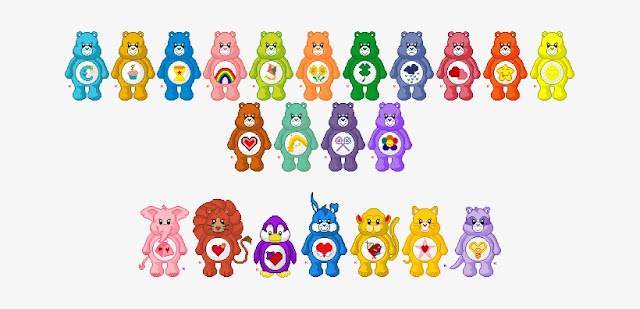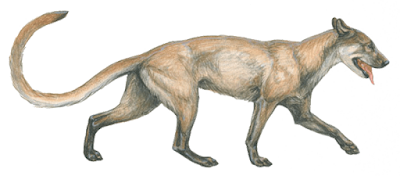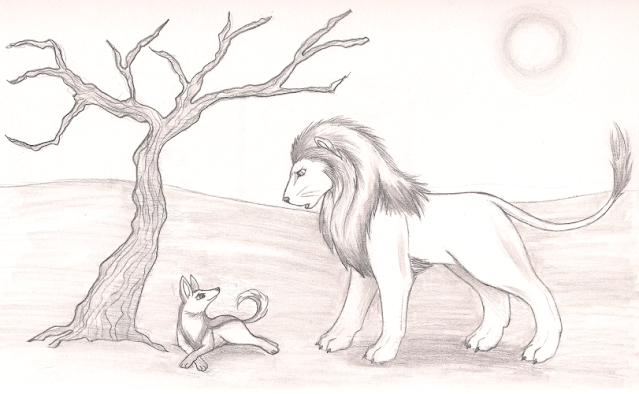The reality of Care Bears
The television show Care Bears, inspired by the American Greeting Card characters (and later their toy adaptations) was probably one of those elements that got me interested in animals when I was a child. It seems to be the only element in the world where Bears are given more importance than animals who would either rival them or obtain some kind of superiority over them. Those animals in the Care Bears team who are not Bears are (ironically) referred to as the ‘Care Bear Cousins’; examples include Brave Heart Lion, Lotsa heart Elephant, Proud Heart Cat, Playful Heart Monkey, Bright Heart Raccoon and Swift Heart Rabbit just to name a few
However in reality many of the Care Bear cousins would actually share a rivalry with/against Bears which is something I came to understand as I watched the series further. Despite Care Bears being cute and cuddly just as any Teddy Bear would be and inspiring love and kindness, it is a known fact that Bears are actually deadly animals in real life This inspired me to want to write about how that presents itself
Lions
It is known that while the Lion, the king of the animals, lives mainly in Southern Africa and East Africa with a tiny population inhabiting Western India, Bears live in North America, Europe, India, China, Japan and most of Southeast Asia. Even though India is the only place in the world where Bears and Lions are found, the two species do not intermingle, a fact born out of the history of Indian wildlife where the Gir Forest, the only home of the Lion out of Africa today was once inhabited by Bears in addition to Lions yet today it is only the latter who is the top predator of the national park. What is known for a fact though is that during the Ice Age in the United States, Bears and Lions would always fight over territory and food whenever they encountered each other. A single Lion evidently would not have won a fight against a Bear and only in larger numbers of more than two or three would have been able to either bring down or see off a Bear. While prehistoric Lions mainly favoured horses and reindeer as prey, they like their modern-day descendants were opportunists and went onto hunt larger animals such as mammoths, bison and musk ox. Sometimes they turned their attention to Bears for food as well
Prehistoric Lions and Short-Faced Bear fighting over a deer
While Bears and Lions may have fought each other in the Colosseum during Roman times, the only rivalry between Bears and Big Cats today lies in India and Asia. The Asiatic Black Bear and the Sloth Bear are two of the most vicious of the Asian Bears and have been observed getting into conflict against Tigers. During the rule of the British in India, Bears were actually considered more dangerous than Tigers and were more sought after more than the lord of the jungle. In the 2008 3-part BBC series ‘Tiger Spy in the Jungle’ about a family of Tigers filmed in Madhya Pradesh’s Pench National park, one of the settings for The Jungle Book by Rudyard Kipling (1865-1936), about the filming of a family of Tigers, a female Sloth Bear and a female Tiger confronted each other non-physically with grunts and snarls before the former simply ran off. In both cases, the animals were mothers trying to protect their young although the Bear was taking a break from her cubs while the Tigress was eating with her offspring. Another big cat that Sloth Bears and Asiatic Black Bears have been known to fight is the Leopard and as is much the case with Tigers, Bears will sometimes steal a Leopard’s kill either when a Leopard is not looking or when the Bear has more advantage over a Leopard. While Leopards may often hunt Bears for food, this is less compared to Tigers who may actively hunt Bears although they take a great risk in doing so as Sloth Bears’ powerful claws may make a Tiger give up the stalking or pursuit of a Bear. With Sloth Bears, a Tiger may sneak up on a Bear who is about to feed or is feeding on a termite mound and jump from behind before savagely biting and twisting either the limbs or neck of the animal. While the Bear panics from blood loss or trying to be free from paralysis, the Tiger has the advantage of killing the Bear. Tigers are known for mimicking the calls of various animals to attract them and since Tigers often mimic the call of Sambar Deer, Sloth Bears are fearful even when the noise comes from a real Deer.
Tiger fighting Sloth Bear near lake in Tadoba national park
Mowgli sharing fruit with Baloo in The Jungle Book
Elephants
It is a known fact that most Elephants cannot stand Bears and will charge at them. This was noted by many British officers in India, especially one who noted that an Elephant belonging to a friend of his became agitated and aggressive not only around Sloth Bears but even around Cows. In the 2012 BBC Documentary ‘The Real Jungle Book Bear’, the first (wildlife) documentary to focus exclusively on the Sloth Bear (who is thought to have inspired the character of Baloo in Rudyard Kipling’s The Jungle Book stories) a Sloth Bear drinking at a waterhole, passively retreated when a herd of Elephants came to the waterhole to drink as did a herd of Chital Deer (also known as Spotted or Axis Deer). An irony though, given that the Sloth Bear is the national park where the documentary was filmed. However Near Tadoba national park (the only national park out of Madhya Pradesh to be the setting of The Jungle Book) where there are no wild Elephants a female Sloth Bear had grown agitated on seeing domesticated Elephants entering the park ferrying visitors. Her aggressive antics caused many dangerous disruptions and sometimes the mahouts had to call off the safari and return with their elephants and visitors. On one occasion, she actually chased an Elephant and the animal’s rider all the way out of the park which she had surprisingly come out of. She was eventually caught and relocated to another national park

British officers and their Indian guides on Elephantback and Horseback hunting Asian Black Bears with the help of their Dogs
Evidently, monkeys being smaller than Bears will always scurry up the nearest tree when they see one approaching. In the 2012 documentary ‘The Real Jungle Book Bear’ which followed the Sloth Bear who is thought to have inspired the character of Baloo in Rudyard Kipling’s The Jungle Book, a troop of monkeys was feeding on jackfruit when a Bear arrived, causing them to scatter up the tree from where the jackfruit came. The Bear however did nothing to harm them (given that even though Sloth Bears eat meat they do not hunt for prey) and instead fed on the jackfruit although the monkeys refused to come down until the Bear left. However in the 1970s, there were reports of Asiatic Black Bears having killed langur monkeys for food. This sometimes is still reported although not as much as when it first was
In Rudyard Kipling’s The Jungle Book stories, the Bandar Log are a troop of monkeys who kidnap Mowgli, prompting his mentors Baloo the Bear and Bagheera the Black Leopard to launch a successful rescue of him with the help of the python Kaa. Much like Bagheera and Kaa, in defence of Mowgli, Baloo is shown fighting the monkeys although often roars before swiping at a monkey
Raccoons will always retreat into holes or climb the nearest tree when a Bear approaches although in some cases, raccoons are known to fight back if the Bear does not give up the chase. However most of the time it is the Bear that wins. When hunting Raccoons, Bears use the same tactics that (ironically) Tigers in India and Asia do to hunt them by sneaking up on Racoons who may be distracted with garbage material or fallen fruit and pounce on them. Sometimes, given that a raccoon is more agile than a Bear, the raccoon may quickly and agilely run if a Bear has missed his/her target
The Red Panda which is a Raccoon not a Bear
Horses are often intimidated by Bears and are known to flee from them at first sight. This was observed by many British officers in India and this was used to an advantage by many who went hunting and chose Bears as their targets while on horseback
Illustration of British Officers hunting a Sloth Bear on Horseback
A
similar tactic was used by Native Americans shortly after horses were
introduced to North America by European settlers and Natives started making use
of horses as well. When Native Americans went hunting, apart from bison and
deer, they also hunted bears as they believed killing dangerous animals such as
bears was a rite of passage into manhood. It was both an advantage and a
disadvantage for them as Grizzly Bears given their inevitable physical advantage
were not only put off by horses but would always try to kill them to throw
their assailants off their backs and it was not only many Native Americans who
were severely wounded or died during Bear hunts but also many Horses as well
There is a long history of Bears being found guilty of killing Sheep and so have been shot by angry farmers for livestock predation. This is especially in the case of the Grizzly Bear which was a problem for this very reason although careful measures are being taken to ensure that Bears will not kill Sheep or any other kind of livestock for that matter. In the wild however, Bears in both Asia, Europe and the United States hunt members of the Deer Family, Deer themselves and Wild Sheep in one way or another. Asiatic Black Bears, being the most carnivorous of all Asian Bears are known to hunt for their food and among the animals that they hunt are the Takin a form of wild Sheep. In the United States and Europe, Bears have also been observed killing Deer by either chasing them and running them down. The Musk Ox is actually related to sheep and goats than to cattle and apart from Wolves also face danger from Bears. From both prehistoric and present times, Musk Ox have defended themselves from both Wolves and Bears by forming protective circles around their young and keeping the enemy at bay with their horns although Wolves or Bears can panic the circle causing it to break. While Musk Ox have more success with killing Wolves that break the circle but the same is not true for Bears which have more of an equal advantage against the Musk Ox
Dogs
It is ironic that while Bears and Dogs are distant relatives, they are antagonistic towards each other. A single dog will inevitably flee from a Bear but larger numbers domesticated or wild will always work together to either kill or see off a Bear. Greyhounds were sometimes used in historical times to hunt Bears while accompanying their masters who would be seated on Horses with guns (see section on Elephants for more). Some members of the Dog family such as Foxes will sometimes scavenge Bear kills but they take a great risk in avoiding injury from the Bears

Polar Bear chasing away Arctic Fox
There are a few members of the Dog family who will always rival Bears or target them for food. In the BBC documentary ‘Land of the Tiger’ which focused on the wildlife of India, a Sloth Bear was chased away by a Jackal defending his family in the Kanha national park, one of the settings for Rudyard Kipling’s The Jungle Book. Wolves will sometimes also target Bears for food although this is more in the case of Bhutan and Tibet. Both the above actually have references to Kipling’s stories although the Jackal is a rival to the Bear while the Wolf is an ally. In the stories, the Dhole which proved more of a threat than the Tiger is an enemy of the wolf pack and Mowgli and the wolves come together to battle the Dhole. Baloo plays a major part in the battle and given his physical advantage has more of an easy way of defeating the Dholes, gradually helping Mowgli and the Wolf Pack to end the terror of the Dholes
The animal that was discovered to draw the link between the Dog and the Bear was the Cynodictus also known as the Bear Dog. Even though they were from a family that represented the distant relation and ancestry between Bear and Dog they were more Jackal-like and would not have tackled prey much larger than themselves. Apart from that very few lived in packs and females often had a difficult time trying to fend for themselves and their pups. Recent research shows however that even though the Bear-Dog was related to both Bears and Dogs, the animal was more Dog than Bear
Cynodictis the 'Bear Dog'
RabbitBears and Rabbits live on the same continent but the Bear will always view the Rabbit as a source of food. While Bears are fast runners, Rabbits are often able to add swift movements to their runs and thus would be capable of overtaking an attacking Bear. Winnie-the-Pooh is the only element where the Bear and the Rabbit get along
In Disney's Winnie the Pooh franchise based on A.A Milne's stories, Rabbit is a friend to Pooh but often gets irked by Pooh's fondness for honey
Penguin
Given that Bears and Penguins live on different continents it is way out of the question that either species would come into contact with each other. Ironically a few games involving both the Polar Bear as the Penguin have the latter as the hero and the former as the villain
Still from the Android App 'Flying Penguin'
The End


















Comments
Post a Comment